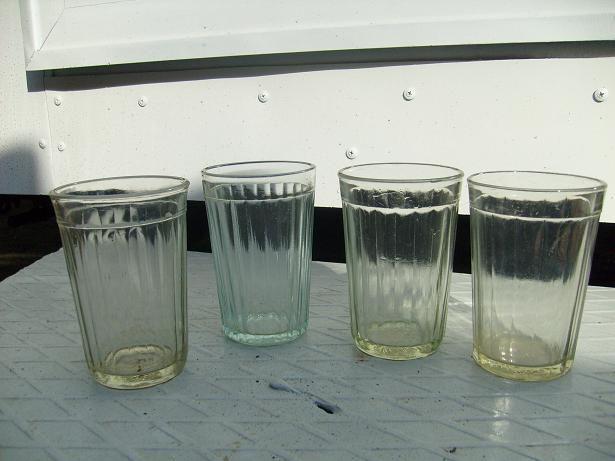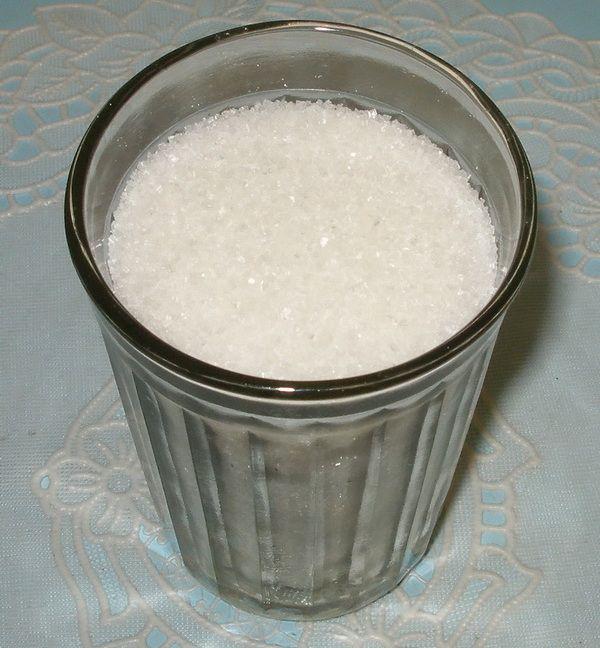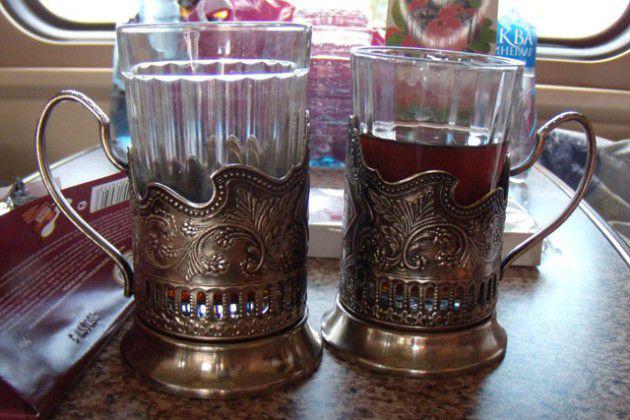4470
Faceted glass. Myths and legends
8 interesting facts about the Soviet faceted glass
September 11 marks 70 years of famous Soviet faceted glass.
This essential attribute of Soviet life was first produced in 1943 at the oldest glass factory in the Russian town of Gus-Crystal is in the form in which we are accustomed to seeing.

Classic dishes Soviet times, today faceted glass becomes a rarity. We offer to meet with interesting facts about this faceted dishes.

1. The Soviet faceted glass sculptor created. At least, so it is considered that the design of this glass is designed by the famous Soviet sculptor, creator of the famous monument "The Worker and the Collective Farm Woman" Vera Mukhina. According to one legend, it has created this "masterpiece" of glassware, along with the author of "Black Square" by Kazimir Malevich in the besieged Leningrad in 1943.

2. The cost of glass depend on the number of faces. Cups produced with 10, 12, 14, 16, 18 and 20 faces. There were 17, but the release of an odd number of sides is more complex, so stopped at the most appropriate and convenient - with 16 facets. The first cut-glass tumblers were 10 faces, and cost three pennies. Classic 16 Granite - 7 cents, and if more than grooved, with 20 facets, is 14 cents. But the capacity of glass has remained unchanged: to the rim of the glass - 200 ml to the brim - 250 ml.

3. The emergence of faceted glass due to scientific and technical progress. This form and structure of glass production dictated a necessity, not a fantasy artist. Even before the war by Soviet engineers had invented a miracle of technology - a dishwasher, which could wash dishes only a certain shape and size. Such glass is very suitable for this unit, and also it was a very strong due to the thickness and specific method for manufacturing glass.
4. Soviet faceted glass related well-known expression "figure for three." Under Khrushchev banned the trade in strong drinks bottling and sale of cleaned very comfortable bottle called "merzavchik" - 125 ml and "chekushku" - 200 ml. Now, a half-liter bottle 2 cups did not fit and was divided into three perfectly - "conscience." When poured into a glass to the rim of the glass, it includes exactly 167 grams, which is a third of a half-liter bottle.
5. Moldavian historian calls the Soviet faceted glass, as the cause of alcoholism in Moldova. According to Vyacheslav Stavila, until 1944, while the Soviet troops were not released Moldova from Nazi invaders in the country drank from small glasses of 50 milliliters. Soviet soldiers brought faceted roomy glass-resistant and durable fall. After that Moldovans began to drink more.
6. The people of the Soviet faceted glass called "Malenkov." This is due to the Minister of Defence George Malenkov, who ordered for certain categories of military personnel were allocated 200 g of the beverage issued in the afternoon. Those who did not drink, was allowed to trade their rations in the amount of glass tumbler on rations or sugar. This rule did not last long, but very memorable to many who served at the time.

7. In the 80-ies of XX century Soviet thick glasses became massively explode. The people there were rumors of a new campaign, the machinations of the capitalists, encroached on the "sacred" and select the most successful sites. But it was much more prosaic. On the factory put imported production line of glasses and stopped to consider the precise manufacturing techniques. As a consequence, the glasses began to crumble, to burst at the seams, they fell off bedplate. One woman "exploded" covered the holiday table. This fact was noted in one of the editions of the satirical newsreel "wick».
8. Soviet faceted glass everywhere used in catering. It is well known fact. But few know that this fact is recognized by experts unofficial cultural signs of the Soviet era, as a symbol of something the public, a public that unites. And this is true. General thick glasses stood in water dispensers in the dining room with compote and yogurt, with tea and jelly in kindergartens and schools.

A railway is still serving tea in a Soviet-style faceted glasses with coasters, surprisingly nice and cute.
The history of the famous dishes faceted continues.

Source:
September 11 marks 70 years of famous Soviet faceted glass.
This essential attribute of Soviet life was first produced in 1943 at the oldest glass factory in the Russian town of Gus-Crystal is in the form in which we are accustomed to seeing.

Classic dishes Soviet times, today faceted glass becomes a rarity. We offer to meet with interesting facts about this faceted dishes.

1. The Soviet faceted glass sculptor created. At least, so it is considered that the design of this glass is designed by the famous Soviet sculptor, creator of the famous monument "The Worker and the Collective Farm Woman" Vera Mukhina. According to one legend, it has created this "masterpiece" of glassware, along with the author of "Black Square" by Kazimir Malevich in the besieged Leningrad in 1943.

2. The cost of glass depend on the number of faces. Cups produced with 10, 12, 14, 16, 18 and 20 faces. There were 17, but the release of an odd number of sides is more complex, so stopped at the most appropriate and convenient - with 16 facets. The first cut-glass tumblers were 10 faces, and cost three pennies. Classic 16 Granite - 7 cents, and if more than grooved, with 20 facets, is 14 cents. But the capacity of glass has remained unchanged: to the rim of the glass - 200 ml to the brim - 250 ml.

3. The emergence of faceted glass due to scientific and technical progress. This form and structure of glass production dictated a necessity, not a fantasy artist. Even before the war by Soviet engineers had invented a miracle of technology - a dishwasher, which could wash dishes only a certain shape and size. Such glass is very suitable for this unit, and also it was a very strong due to the thickness and specific method for manufacturing glass.
4. Soviet faceted glass related well-known expression "figure for three." Under Khrushchev banned the trade in strong drinks bottling and sale of cleaned very comfortable bottle called "merzavchik" - 125 ml and "chekushku" - 200 ml. Now, a half-liter bottle 2 cups did not fit and was divided into three perfectly - "conscience." When poured into a glass to the rim of the glass, it includes exactly 167 grams, which is a third of a half-liter bottle.
5. Moldavian historian calls the Soviet faceted glass, as the cause of alcoholism in Moldova. According to Vyacheslav Stavila, until 1944, while the Soviet troops were not released Moldova from Nazi invaders in the country drank from small glasses of 50 milliliters. Soviet soldiers brought faceted roomy glass-resistant and durable fall. After that Moldovans began to drink more.
6. The people of the Soviet faceted glass called "Malenkov." This is due to the Minister of Defence George Malenkov, who ordered for certain categories of military personnel were allocated 200 g of the beverage issued in the afternoon. Those who did not drink, was allowed to trade their rations in the amount of glass tumbler on rations or sugar. This rule did not last long, but very memorable to many who served at the time.

7. In the 80-ies of XX century Soviet thick glasses became massively explode. The people there were rumors of a new campaign, the machinations of the capitalists, encroached on the "sacred" and select the most successful sites. But it was much more prosaic. On the factory put imported production line of glasses and stopped to consider the precise manufacturing techniques. As a consequence, the glasses began to crumble, to burst at the seams, they fell off bedplate. One woman "exploded" covered the holiday table. This fact was noted in one of the editions of the satirical newsreel "wick».
8. Soviet faceted glass everywhere used in catering. It is well known fact. But few know that this fact is recognized by experts unofficial cultural signs of the Soviet era, as a symbol of something the public, a public that unites. And this is true. General thick glasses stood in water dispensers in the dining room with compote and yogurt, with tea and jelly in kindergartens and schools.

A railway is still serving tea in a Soviet-style faceted glasses with coasters, surprisingly nice and cute.
The history of the famous dishes faceted continues.

Source:























